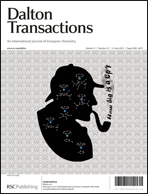Valence-induced assembly of CuI–CuII ions into different discrete coordination architectures by a disk-shaped polypyridyl ligand†
Abstract
The valences of metal ions were found to play key roles in controlling the formation and structures of discrete coordination architectures in a copper and disk-shaped hexa-monodentate ligand system. When CuI and CuII ions react with a polydentate


 Please wait while we load your content...
Please wait while we load your content...